A warm welcome to members of Heath Garden Society! Thank you for inviting me to talk last night. Here are a few photos to inspire you with your bulb planting this autumn!

Snowdrops. Galanthus Nivalis is the common single snowdrop. I wait until they are coming into bud and then dig up a clump and pop them into my Sankey terracotta pots. These pots are special to me as my grandfather used them and gave them to me before he died. I love to use them and think of him gardening with them too. He enjoyed planting primroses, auriculas and miniature daffodils in them. I’ve planted Tete-tete in these and placed them on the potting shed window where I can look at them while I’m working.
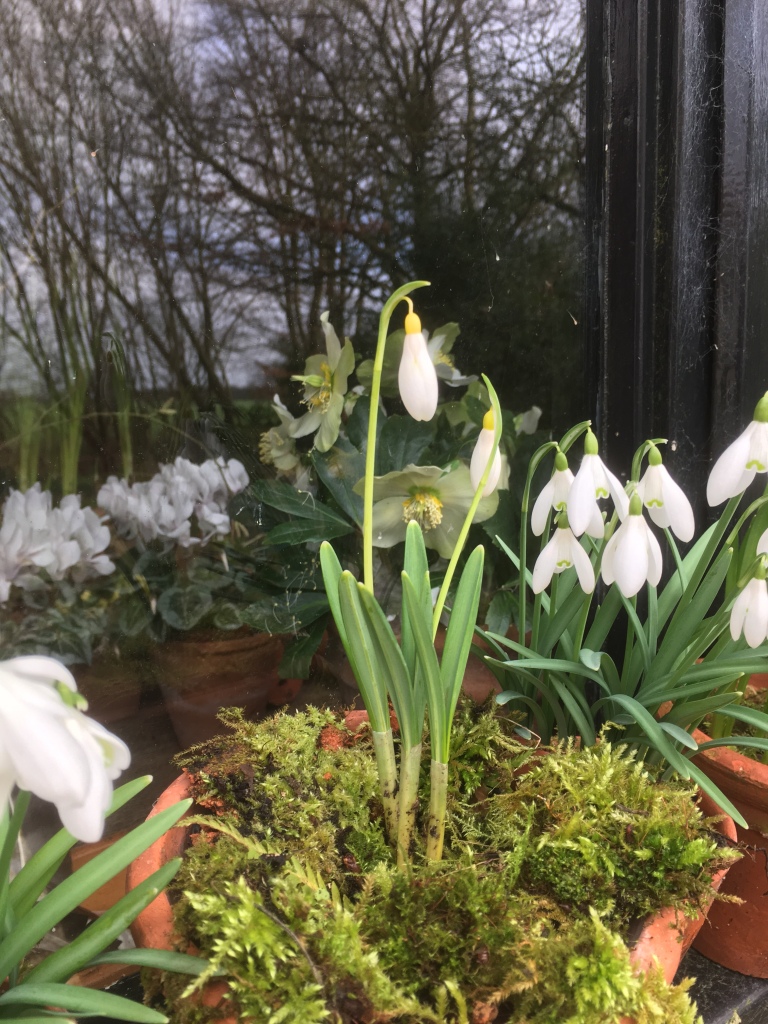
I highly recommended Galanthus Madeline if you like a snowdrop with yellow markings. These were the three I bought from Thenford. A friend suggested we buy a pot and split it between us. This is a great idea if snowdrops are expensive. I think we paid £6 or £7 each, which turned out to be a bargain. The snowdrops bulk up quickly and are strong and reliable.

Within just a few years, my little clump has grown! I love something that thrives and shines out in the winter garden. These are planted under deciduous trees. They’ll flower before the trees come into leaf and then be protected from strong sunlight and heat by the tree canopy. We leave the tree leaves where they drop in autumn and snowdrops particularly love leaf mould.

I can also recommend new variety Polar Bear. These are huge flowers with unusual swept back petals and distinctive green markings. These flower later than the others in my garden and it’s lovely to extend the snowdrop season with something special like this. Luckily, these are usually on sale at Dobbies garden centre and are a fairly reasonable price, about £4-£6 a pot. Look out for them next February.
I wrote about Polar Bear here :
https://bramblegarden.com/2020/03/10/last-of-the-late-snowdrops-and-snowy-pictures-of-my-garden/

Snowdrops and miniature daffodils make a lovely button hole posy. These ones were put onto a willow wreath for my summerhouse.

These little posies are placed into tiny glass or plastic test tubes and wired into the silver birch wreath. It’s easy to make the wreath. Just cut a length of weeping silver birch stems and twist and wind them around, tying at the top. Wire in some 4” lengths of ivy, moss and wild clematis or ‘old man’s beard’ as we call it. Daffodils, iris, cyclamen and crocus will last a week in the test tubes if kept topped up and it’s simple to just add fresh flowers when needed.
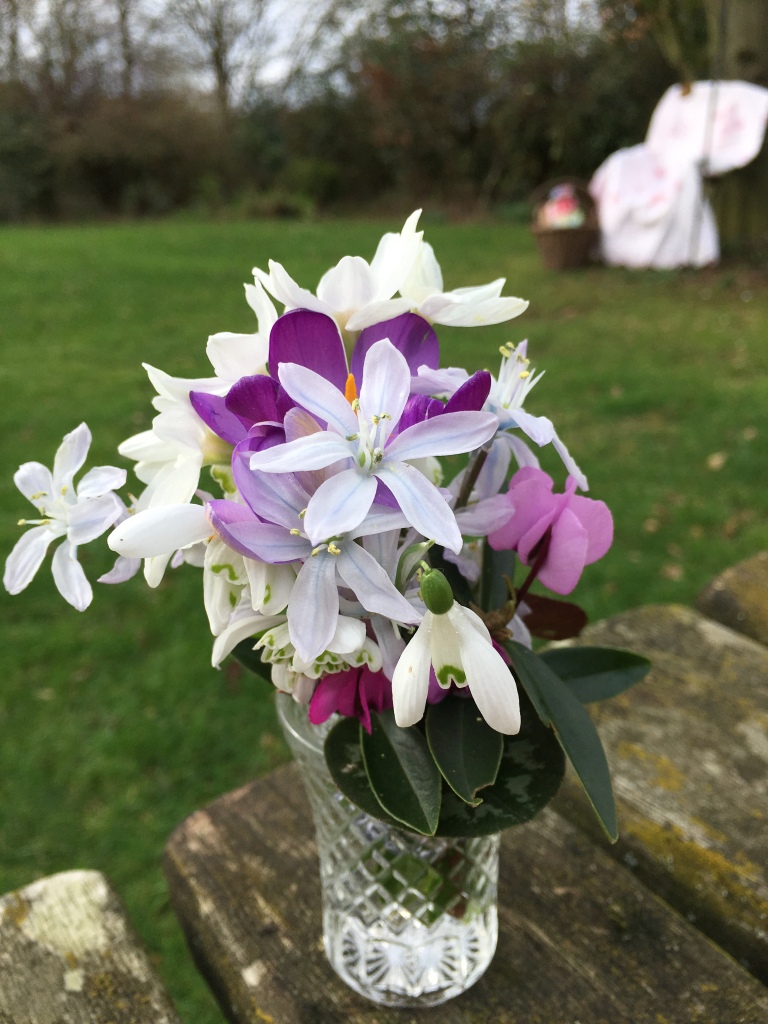
Here’s another tiny posy with snowdrops, crocus, cyclamen and a blue flower I think is called squill. Perhaps you know it? There’s an amazing strong scent for such a small arrangement in a tiny glass vase. Winter flowers are often beautifully-scented as they have to work hard to attract the few pollinators that are about.
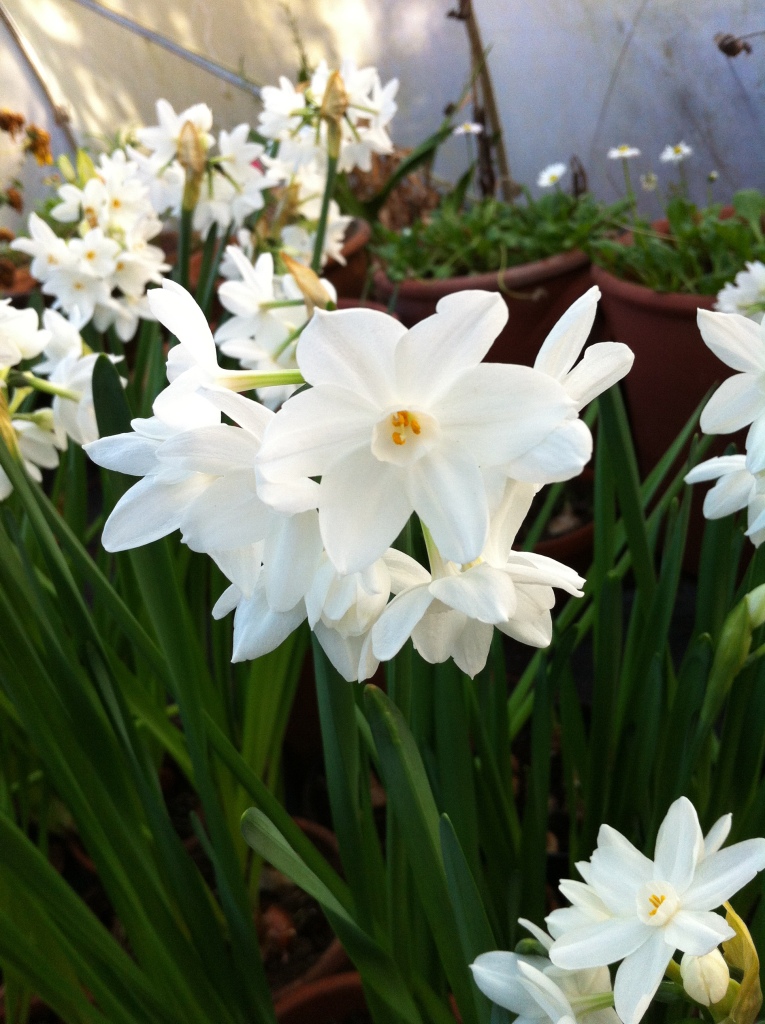
Talking of scent, I don’t think you’ll get anything with a stronger scent in winter than Paper White narcissi. We start ours off in plant pots at the end of September. Six bulbs to a 7” pot. They’ll take about nine weeks to flower, depending on temperatures. You can bring them on for Christmas by bringing them in from a cold greenhouse. Always start them off in a cool place, or they will grow tall and leggy and won’t root as well. You can extend the flowering season by bringing pots indoors in sequence right through to March. Paper Whites are not hardy so they won’t grow outdoors, but I start mine off in an unheated poly tunnel which gives them just the right amount of protection to grow well. If I want to make a big indoor display, I select pots with flowers all at the same stage and just place them in a large cache pot, topping them off with moss to hide the pots. No one would know that I’ve cheated! We use Dalefoot sheep wool and bracken compost specially created for bulbs. This compost is a favourite of mine as it gives Lake District farmers an income for their wool- which would otherwise go into landfill. Also the compost doesn’t break down and disintegrate like some other peat-free types. The other compost we use is Melcourt multi-purpose with added John Innes. We add grit and vermiculite to these, depending on what we want to grow.
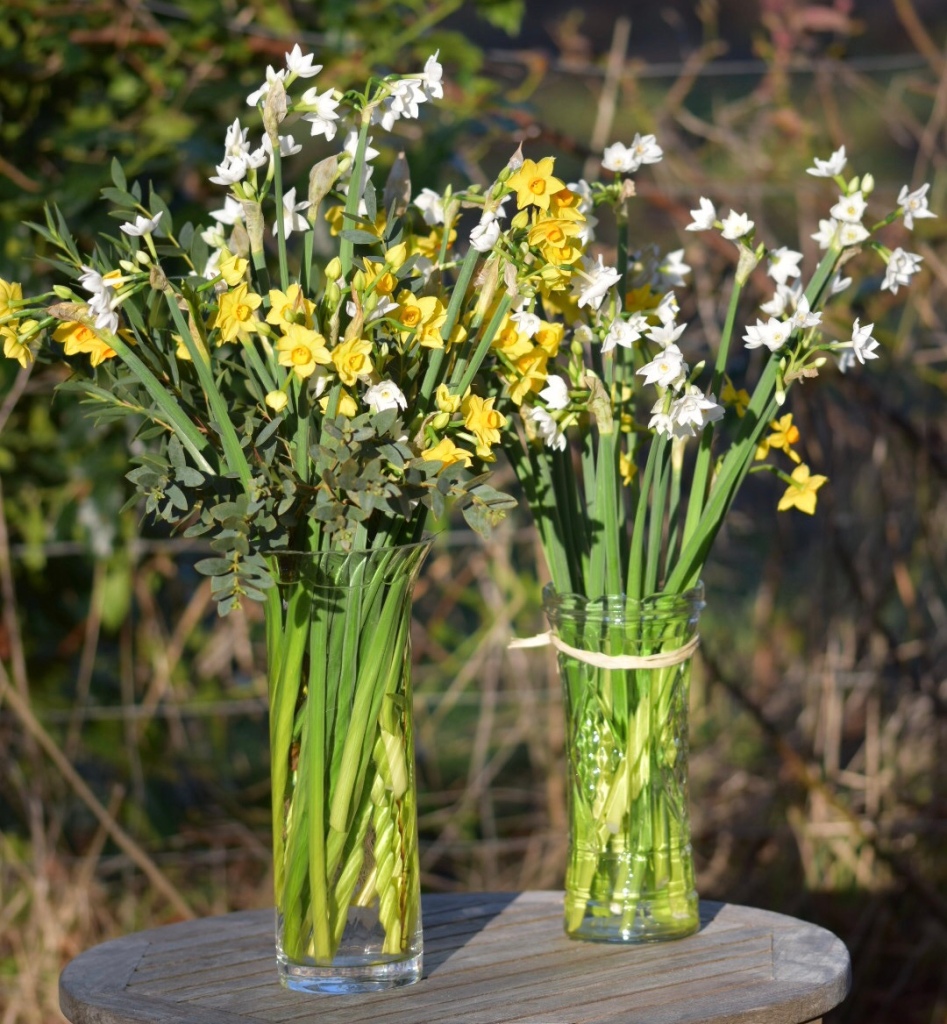
Here’s some Paper White and Soleil d’Or brightening up January!
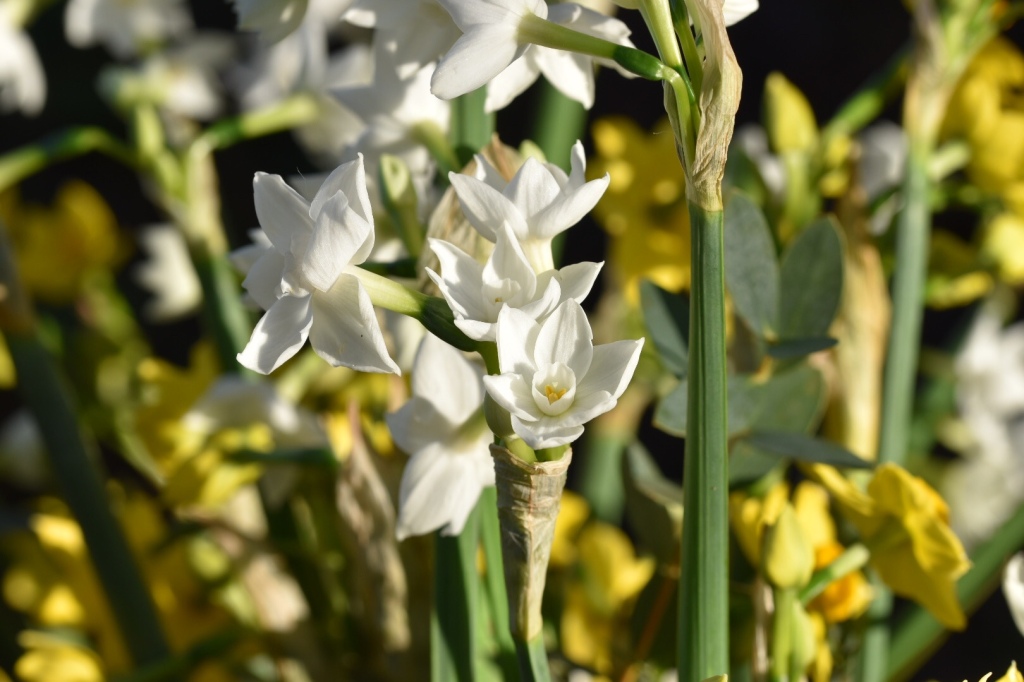
Such a lot of scent from such small flowers.

Planting a selection of varieties mean you’ll have daffodils from January through until May. Cedric Morris is first to flower outdoors. February Gold (above) usually flowers at the end of February. Tete a tete in March. The last daffodil to flower is Hawera in May.

Another new variety which has become a firm favourite is Snow Baby (above). This flowers for a long time, coping with strong winds, hail, snow. It starts out pale lemon and fades to white. Such a beauty on short, strong stems.
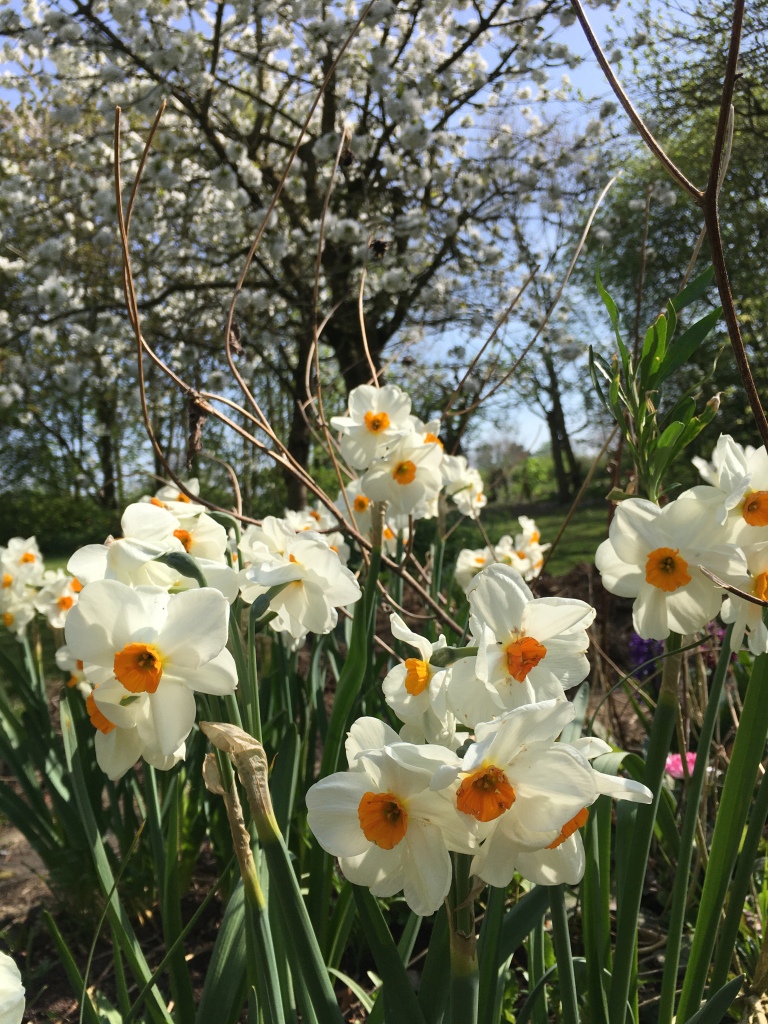
I like to have heritage types in the garden, along with the latest varieties on trial. Historically, fruit growers used to have daffodils amongst their apple and pear trees to give them a spring income, and fruit bushes such as redcurrants and blackcurrants for a summer income. I like to keep up traditions like this, so I’ve planted heritage narcissi Geranium under my trees. These make a lovely scented bouquet in spring.

Here I’ve combined the old with the new. Narcissi Geranium with a new tulip called Exotic Emperor. These are ‘lasagne’ planted. Four inches of compost is placed in the bottom of a large Italian pot, and 25 tulip bulbs set on top. Another 4” of compost is set with another 25 tulips. More compost and 25 daffodil bulbs. Another 4” and 25 more daffodils. Then top up with white Carnegie hyacinths, white Joan of Arc crocus and snowdrops. I’ll have flowers from February through to May. I only have one expensive Italian pot so I want it to work really hard for me. It’s placed under my office window so I can look out at it while I’m working.

If I could only grow one tulip it would be Exotic Emperor. It reminds me of swan feathers. I love the green flash too. Double tulips last much longer than single tulips. There are more petals to open, which makes them good value.
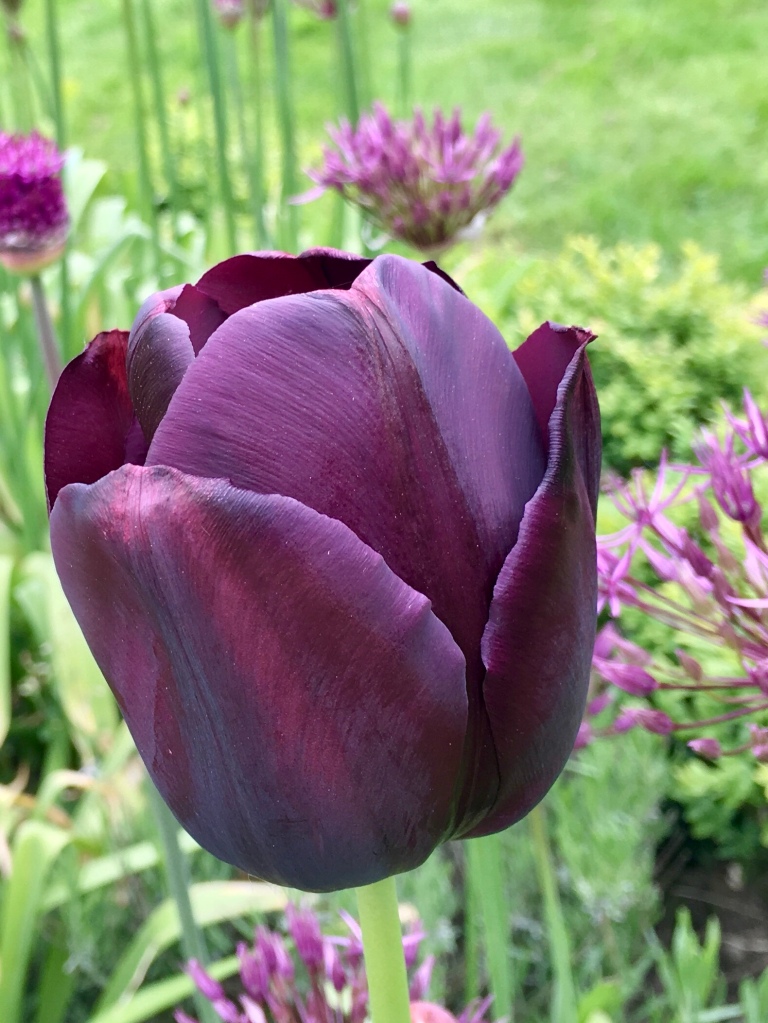
Queen of Night is another tulip I use a lot in my garden design work. It’s long lasting and stands up to the weather.

Here it’s growing with Allium Purple Rain, a hybrid between Purple Sensation and Christophii. Highly recommended. Also look out for new summer-flowering allium Millennium. Hardy’s plant nursery sells this variety at flower shows and mail order.
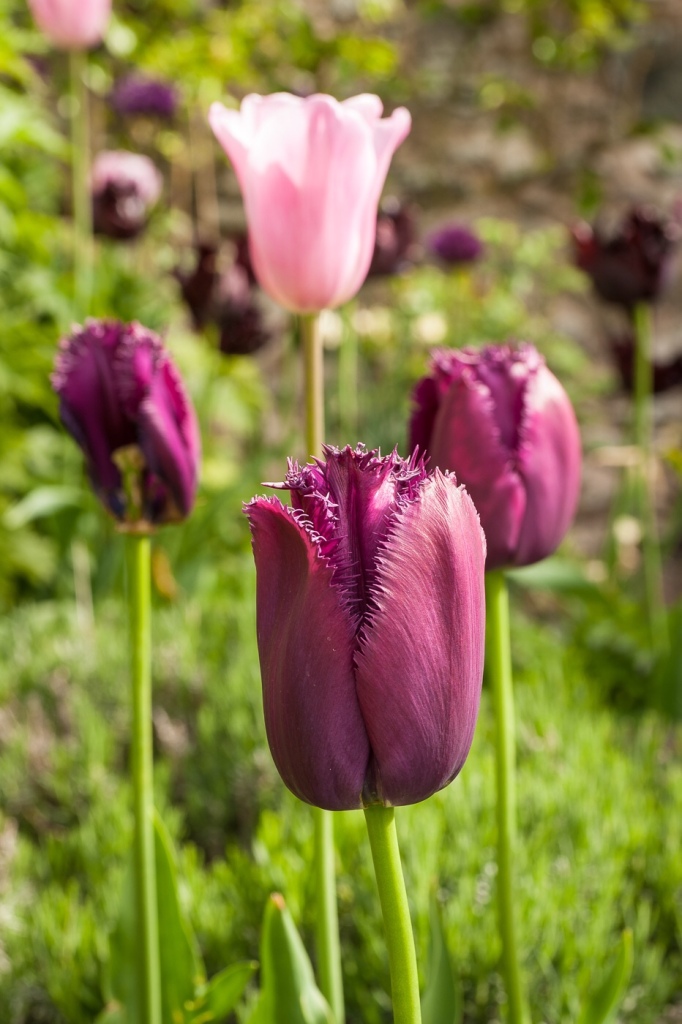
For a pretty, fringed tulip, try Curly Sue. And my favourite pink tulip is Violet Beauty. We buy from Gee Tee Bulbs. Links to the nurseries are at the end of this blog post.

Rapidly moving on to autumn – as your talk was all about bulbs, corms and tubers- here’s Dahlia David Howard partnered with Alstroemeria Indian Summer. I leave my dahlias in the ground over winter, covered with a foot of dry leaves, some compost bags and finally, cloches. As long as they don’t get soaking wet and frozen, they will be fine.

Nuit D’Ete is another top favourite. I love the cactus flowering dahlias for their striking petals. This one also has tinges of deep plum red and black in the centre. A really striking and beautiful flower.

I’ll leave you with a picture of my 1920s summerhouse which is on a turntable. It originally lived in Derbyshire at Flower Lilies Hall. We spent a year renovating it and now love sitting inside looking out at the different views of the garden. Thank you for visiting my blog and reading about my garden. Please leave a message in the box below, and sign up for e mail notifications for further blog posts. I concentrate on growing food and flowers at home- I never have to buy any cut flowers for friends and relatives. It’s all about choosing the right varieties and getting a succession of produce all through the year. It’s a fun challenge and one I love to share with you all.
Links:
Hardy’s cottage plants:
https://www.hardysplants.co.uk/
Also look at In a vase on Monday meme:
https://ramblinginthegarden.wordpress.com/2023/08/28/in-a-vase-on-monday-bluesy-floozy/